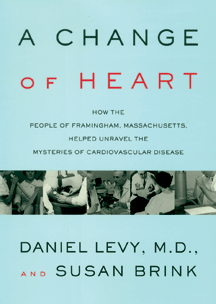The legacy of the Framingham Heart Study.

A Change of Heart: How the People of Framingham, Massachusetts Helped Unravel the Mysteries of Cardiovascular Disease
By Daniel Levy C’76 and Susan Brink
Alfred A. Knopf, 2005. $26.95
By Huntly Collins | On October 11, 1948, more than 40,000 Bostonians filled Braves Field for the sixth and deciding game of the World Series against the Cleveland Indians. Hundreds more watched the game on televisions set up in Boston Common.
But the real news that day was happening a few miles away in the Boston suburb of Framingham, a manufacturing town of 28,000. There, out of the limelight, the U.S. Public Health Service quietly began a longitudinal study that would ultimately change the face of medicine and save the lives of millions of Americans at risk of heart disease.
The Framingham Heart Study, as it came to be called, was the first of its kind. Instead of studying people who had experienced heart attacks or stroke, it would follow 5,209 healthy Framingham residents over two decades to see who succumbed to cardiovascular disease. Researchers would then work backward to analyze those factors—such as diet, exercise, and smoking—that might be correlated with the risk of disease and death.
Today such risk factors have become the cornerstone of public-health consciousness in America. But 50 years ago, doctors had no idea what caused heart disease and dismissed the notion that prevention was even possible. Instead, heart disease was seen as an inevitable consequence of old age. Some physicians, in fact, believed that high blood pressure was a good thing because it increased the supply of blood to vital organs as people aged. It took the Framingham Heart Study to debunk such ideas and set the country on a path to prevent heart disease through lifestyle changes.
The intriguing story of the Framingham Heart Study, which is now following third-generation descendents of the original 5, 209 volunteers, is the subject of A Change of Heart by Dr. Daniel Levy C’76 and Susan Brink. Levy was appointed the study’s cardiologist in 1984 and has been with the project ever since. He is now overseeing a new phase of the work—looking at the interaction of genetics and known risk factors, such as obesity, in the development of heart disease.
“The epidemic of obesity is confounding all that has been learned about controlling heart disease,” the authors write.
The history of an observational study has the potential to be as exciting as warm milk. But Levy and Brink tell their story through the personalities and social forces of the time, creating a compelling narrative that says as much about science, money, politics, and popular American culture as it does about a particular medical study.
In the course of the story, the authors sketch a terrifying picture of Franklin Roosevelt’s heart disease, which was as hidden from the American public as his paralytic polio; they tell the riveting tale of a scientist who refused to give up on his theory that vitamin B played a critical role in preventing cardiovascular disease; and they describe the intervention of Dr. Arthur Caplan, the Emmanuel and Robert Hart Professor of Bioethics who serves as director of Penn’s Center for Bioethics, when Boston University scientists wanted to make money off the Framingham volunteers by selling their genetic data.
(Caplan, it turns out, grew up in Framingham, though his family was not part of the heart study.)
The fact that the study was conducted in Framingham has more to do with the Harvard connections of its founding fathers, including the renowned Paul Dudley White, Eisenhower’s heart doctor, than with anything else. But the choice of the small Boston suburb was fortuitous because Framingham mirrored the rest of the country as it entered the boom years following World War II.
Like a lot of towns, Framingham was solidly middle-class. Its men had returned from war and were heading to work in the new General Motors plant. The women, who ran the factories during the war, went back to the home, where they cooked meat-and-potatoes meals. After dinner, families gathered around the television set, which was just entering the American household. Ironically, the very prosperity that was lifting the hopes of many Americans was also laying the groundwork for a disease that would eventually kill them.
When the Framingham study began, scientists hypothesized that cardiovascular disease was the result of many different factors that worked slowly over time to cause the build-up of plaque in the arteries. But nobody knew what those factors were.
To find out, the study enrolled about half of Framingham’s adult population, men and women between the ages of 30 and 60. Unlike volunteers in the trial of Jonas Salk’s polio vaccine, which involved a one-time shot, these volunteers agreed to report to the study center once every two years for 20 years! At each visit, they had extensive physicals and heart tests and filled out lengthy questionnaires.
Despite the time and effort involved, study participants were sold on the idea that their participation would help to advance scientific understanding of a disease that was killing friends and relatives, often in mid-life.
Nine years into the study, the first preliminary results were published. They showed, for the first time, that the higher a person’s blood pressure or cholesterol, the greater the chance of cardiovascular disease. The findings also suggested that a sedentary lifestyle and fatty diet were among the factors to blame.
That hardly seems revolutionary today. At the time, however, it represented a breakthrough in understanding. If high blood pressure and cholesterol could cause heart disease, then it might be possible to lower the risk of heart disease by reducing blood pressure and cholesterol. And that, of course, is exactly what scientists proved in subsequent clinical trials.
Sadly, new knowledge—even life-saving knowledge—does not necessarily lead to behavior change. Despite the resounding evidence from Framingham and elsewhere, Americans are still eating too much, not exercising enough, and smoking. Today, despite our understanding, heart disease is still the leading cause of death in the U.S. An American dies of cardiovascular disease every 33 seconds.
If A Change of Heart has a shortcoming, it is the book’s failure to grapple sufficiently with that conundrum—to explain why we don’t do what we know we should do and offer some possible solutions. If scientific knowledge does not spur rational behavior, what’s the point of it all? Short of the development of an obesity pill, perhaps that’s the next big research area for the Framingham investigators to pursue.
Huntly Collins is a Philadelphia writer and former medical reporter at The Philadelphia Inquirer.




